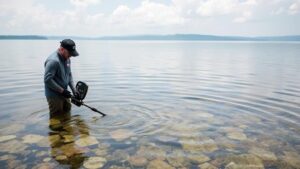Recovering Lost Jewelry in Public Beaches After Storm Surges
Recovering Lost Jewelry in Public Beaches After Storm Surges
Storm surges, often associated with hurricanes or severe weather events, can significantly alter coastal landscapes, leading to the loss of personal belongings such as jewelry. Public beaches, frequented by tourists and locals alike, become hotspots for recoveries post-storm. This article will delve into the best practices, tools, and technologies available for recovering lost jewelry after storm surges, providing a comprehensive understanding of this often-overlooked activity.
The Impact of Storm Surges on Coastal Areas
Storm surges are defined as a rise in seawater level attributed to a storm, primarily driven by strong winds and low atmospheric pressure. As tides rise, beaches are subject to extensive erosion, shifting sediment, and the loss of items left behind by beachgoers. Studies indicate that storm surges can raise water levels by as much as 20 feet in extreme cases, resulting in significant geographic changes.
- A 2018 study by the National Oceanic and Atmospheric Administration (NOAA) revealed that coastal communities experience an increase in storm surge occurrence due to climate change.
- During Hurricane Harvey in 2017, it was reported that beaches saw an increase in lost items during the surge, with estimates of personal belongings in the millions across impacted areas.
Best Practices for Recovery Operations
Following any storm surge, coordinated recovery efforts can maximize the chances of reclaiming lost jewelry. Here are some recommended best practices:
- Timing is Critical: Begin recovery efforts promptly after the surge has subsided. sooner you search, the less likely items will be buried or moved by subsequent tides.
- Research Local Regulations: Before embarking on a recovery mission, understand local laws regarding the recovery of lost items. Many beaches have specific policies regarding metal detecting and treasure hunting.
- Bring the Right Tools: Equip yourself with metal detectors, shovels, and buckets. Metal detectors can help find metallic jewelry quickly, while shovels can assist in digging through sand and debris.
Tools and Technologies for Jewelry Recovery
The evolution of technology has provided treasure hunters with sophisticated tools that improve the likelihood of successful recoveries. Here’s a look at some essential tools and their applications:
- Metal Detectors: These are invaluable for locating lost jewelry, especially for items made of gold and silver, which are often used in fine jewelry. High-quality models can differentiate between types of metals, reducing the time spent on unwanted targets.
- Handheld Magnifiers: For inspecting small, intricate pieces that may be obscured by sand or debris, magnifiers can aid in identifying the exact location of items.
- Beach Scoops: Specialized beach scoops allow for quick sifting and retrieval of small items after the initial detection.
Case Studies: Successful Recoveries
Real-world examples can illustrate the challenges and successes faced during jewelry recovery efforts:
- A local group in Florida organized post-hurricane recovery efforts, utilizing metal detectors to recover over 150 pieces of lost jewelry from a popular public beach. Their findings were showcased in a community event that raised awareness about beach safety and debris removal.
- In California, a professional treasure hunter recovered a diamond wedding ring worth over $10,000 after a storm surge. recovery process involved meticulous searching with advanced metal detection technology, underscoring the significance of professional techniques in successful recoveries.
Preventative Measures to Protect Valuables
While recovering lost jewelry is important, preventing loss is even more critical. Consider adopting these practices:
- Use Waterproof Containers: Storing jewelry in waterproof bags can help mitigate the risk of losing valuables during storms.
- Leave Valuables at Home: Avoid bringing items of significant personal or monetary value to the beach, especially during storm season.
- Engage with the Community: Participating in local beach clean-ups and educational programs about storm preparedness can create community resilience.
Conclusion
Recovering lost jewelry from public beaches after storm surges presents unique challenges. By understanding the impacts of storm surges, implementing best practices, harnessing appropriate tools, and learning from past successes, treasure hunters can enhance their recovery efforts significantly. Also, employing preventive measures can safeguard personal belongings, ensuring a more enjoyable and worry-free beach experience. Ultimately, both recovery and prevention strategies serve to protect not only individual property but also the collective enjoyment of coastal areas.



